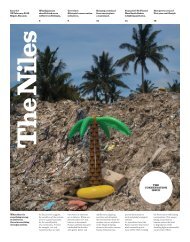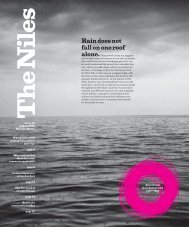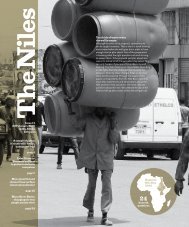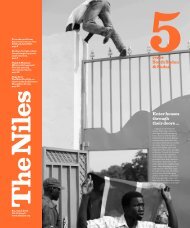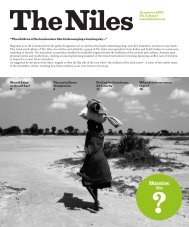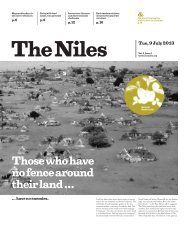We are what we eat
The food we eat literally determines who we are. It influences our physical, mental and even emotional well-being. From Egypt’s Cairo to Burundi’s Gitega, this issue of The Niles attempts to explore the essentials of food: from conflict and food insecurity to the sensory aspects of preparing and eating national dishes.
The food we eat literally determines who we are. It influences our physical, mental and even emotional well-being. From Egypt’s Cairo to Burundi’s Gitega, this issue of The Niles attempts to explore the essentials of food: from conflict and food insecurity to the sensory aspects of preparing and eating national dishes.
You also want an ePaper? Increase the reach of your titles
YUMPU automatically turns print PDFs into web optimized ePapers that Google loves.
“I don’t buy
cabbage and
potatoes from
the market.
Instead, I feed
my children from
my garden.”
20
little plot so that we get better harvests,” said 38-yearold
housewife Mulu Abegaz. Abegaz has four
children and has lived in Hadid Gebeya village
for over 22 years.
“I don’t have words to express how urban
agriculture is benefiting me. I don’t buy cabbage
and potatoes from the market. Instead, I feed
my children from my garden,” she said, smiling.
Growing food in cities for human consumption
is one way to increase global food supply in the
face of rising population growth and global food
security concerns.
The capital city of Addis Ababa is rapidly changing
from a traditional agricultural community
to one that is competitive in the global economic
market. Addis Ababa is the most populated city
in the country, with a total of 3,384,569 inhabitants,
according to the 2007 census. Current estimates
put the population at over seven million. The majority
lives in slums.
Due to the fact that rural Addis Ababa city
immigration is increasing at an alarming rate,
agricultural lands have been converted to industries,
apartments or condominiums. Slums are rapidly
expanding, even in the peripheries of the city. The
population density is estimated to be near 5,165
individuals per square kilometre.
Tsedale Mengesha, a 51-year-old housewife has
six children and has lived in the slums for nine years.
She beautifies her plot with ornamental flowers
and with food plants.
“I have been growing cabbage, Swiss chard,
chilli pepper and tomato on this little plot and I
benefit from them. I have reduced some of my
expenses by growing my own vegetables,” said
Mengesha.
Peri-urban (farming in fringe parts of the
city) and urban agriculture have the potential
to provide food security for many people in
Addis Ababa.
“We are working to secure food at the household
consumption level in the city by initiating
the people who are living in both government and
private houses and supporting the communities
to engage in urban gardening and animal development,”
said Assegid H. Ghiorgis, Head of Urban
Agriculture Division at Addis Ababa City Government
Administration.
According to the UN Development Programme,
some 800 million people, or nearly eight percent
of the world’s population, are now engaged in urban
agriculture worldwide.
Rural poor move to cities
In Ethiopia, like many developing countries,
the increasing concentration of people in the urban
areas, has put enormous pressure on food supply
systems in both urban and rural areas.
The majority of migrants come to the city from
the rural areas that are often plagued with drought
and political instability. They contribute to the
growing low-income Addis population, which
lacks access to adequate food or the financial means
to buy it.
According to Assegid, the city government offers
support and monitoring to 96,411 people in the city
who are engaged in urban agriculture at the household
consumption level.
“We have 2,160 farmers within five city expansion
sub-cities with a land of 4,444 hectares; thus, we
are helping them by deploying agricultural extension
experts, giving fertiliser and seeds. There were
80,000 tonnes of agricultural produce at the city
level last year,” said Assegid.
Slight increases in food prices and available
land for cultivation push many individuals and
families into food insecurity. With this in mind,
there is a growing movement of the city government
to empower the efforts of farming within the city
at household consumption level by a new organisational
structure.
Dereje W. Mariam, a 43-year-old urban pastoralist
and father of three, lives in the heart of
Addis Ababa’s Kirkos-Hadid Gebeya village. He
has two degrees in accounting and management
and was a bank employee, but he resigned from
his job six years ago and started to work in livestock
production.
Dereje invested ETB 13,000 (about USD 435)
of capital to start farming. He has 16 milk cows, his
own home and a car. He earns between ETB 30,000
and 50,000 (USD 1,005 - 1,675) per month and
creates job opportunities for six workers.
“I have covered my home consumption and more
than 120 milk customers around my village. There
is a scarcity of fresh milk supply in the city, and I can’t
fulfil the entire demand, so, the government should
give special attention to urban agriculture in order
to solve food insecurity,” said Dereje. His future dream
is to establish a huge dairy farm.
Urban farming in the capital
Urban farming is not new to Addis Ababa. It
has been a major part of the urban scene from the
very beginning of the city’s development as the
capital of Ethiopia. Many of the city’s early residents
cultivated crops, raised chickens, and kept dairy
animals. Well-to-do households raised cows for milk
for home consumption.
Annually, there are two harvests in and around
Addis Ababa, providing an abundance of fresh
produce. Carrots, different types of cabbage, cauliflower,
lettuce, celery and potato are the most
commonly cultivated vegetable crops.
The availability of communal plots and farming
cooperatives already has a history of contributing
enormously to urban farmers’ ability to enter the
market and make a living off their produce, especially
when no other land was available to them.
The city has suitable soil, altitude and year-round
small rivers that are tributaries of the Akaki River,
which is the source of irrigation water for most
vegetable growers in the city.
Although the city’s urban and peri-urban
agriculture has multifaceted economic, social and
environmental benefits, stakeholders also raise
issues of human health and environmental hazards
because of the contamination of pathogens, bad
smells from animal farms and deposits of heavy
metals used in the agricultural systems, mainly
due to intensive use of agrochemicals and using
polluted irrigation water.
“Frankly speaking, urban agriculture needs
clean water, soil and air, but our city doesn’t meet
all three standards. We recently visited our polluted
rivers with FAO and decided to conduct
a detailed survey with its recommendations,”
said Assegid.
Earlier this year, the office of Prime Minister
Abiy Ahmed announced the ‘Addis Ababa Riverside
Project’, which aims to make the city green by
developing and rehabilitating two river streams
of the city. The 1 billion USD project plans to
enhance the well-being of city dwellers by mitigating
river flooding and through the creation of public
spaces and parks, bicycle paths and walkways along
the riversides. The park will cover 23.8 kilometres
and 27.5 kilometres along two rivers flowing from
Entoto Mountain through Akaki River.
“We will exploit the Addis Ababa Riverside Project
as an opportunity to expand urban agriculture and
clean our rivers. We can cover vegetation with food
plants, which can be used as both ornamental and
fruit-bearing, like apple trees,” said Assegid.
3.
Eat with your family, cook with
your grandmother
Food is a family affair in Sudan – from learning the
recipes to weekly gatherings around a large table.
Alaa Eliass
Khartoum, Sudan
In Sudan, like in most of the world, families
gather on the weekend, at one table to share a meal.
In Sudan, this is usually for lunch.
Families are very connected in our culture,
and it is not uncommon to find three generations
living in the same house. When families live
apart, it is especially important to get together and
have lunch. My Egyptian friend tells me it is the
same in his culture, although the meals are somewhat
different.
One of my most wonderful childhood memories
is visiting my grandma’s house and watching her
make the most delicious food while waiting hungrily
and with little patience.
The Sudanese population is made up of a
combination of original inhabitants of the Nile
Valley and migrants from the Arab peninsula.
There are 19 major ethnic groups and over 597
ethnic subgroups speaking more than 100 languages
and dialects. This diversity plays out in a wide
variety of foods.
One of the most popular ingredients, which
every Sudanese meal must include is beans. They
are very cheap in Sudan, which is why they are found
all over the country. It’s also easy to cook. Just boil
the beans with a little bit of salt, onion, pepper and
sesame oil.
Most families in Khartoum depend on bread to
go along with any dish, but that’s only in the capital.
Go further north and kisra replaces bread.
TN14_20191203_II.indd 20 2019/12/03 10:08








